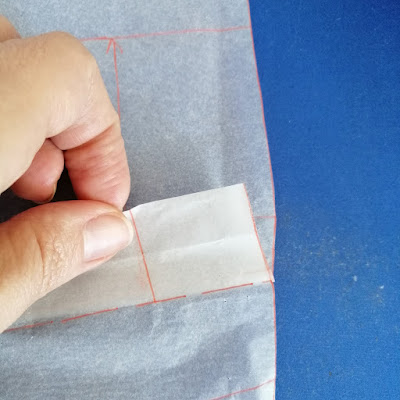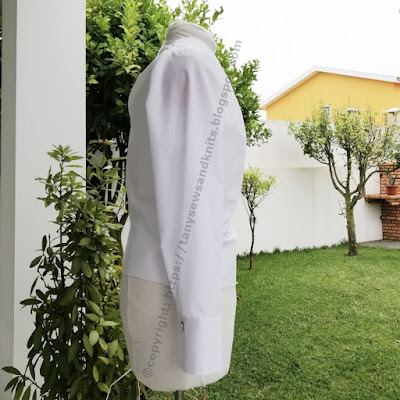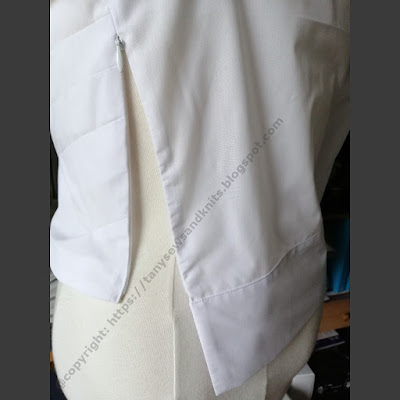EN Summary: Find out all the details of this lovely self-made one-shoulder shirt by reading the full article, which has been originally published on tanysewsandknits.blogspot.com.
---
PT Sumário: Descubram todos os detalhes de como confecionei esta linda camisa de um só ombro, no artigo integral originalmente publicado em tanysewsandknits.blogspot.com.
EN: Here's a photo (courtesy of Revista Patrones) of model 14 included in the #409 issue of Patrones magazine; if you've read my previous article on Tany et La Mode, you already know about the same shirt being sold at some Zara stores around the globe; in the article you'll be able to see some interesting detail photos of this model.
---
PT: Aqui têm uma foto do modelo original (cortesia da Revista Patrones), modelo n14 da revista Patrones#409; se leram o meu artigo anterior no blogue Tany et La Mode, saberão que esta camisa também é vendida em algumas Zaras no globo; nesse artigo poderão ver fotos com detalhes bastante interessantes deste modelo.
EN: My friend Paco used to mail me the Patrones magazines from Spain, before he passed away. Here in Portugal these magazines are a hard to find and often get here with several months delay. I was very pleased when I found out about the new Patrones App allowing to buy digital Patrones issues as soon as the magazines are released, featuring all included patterns in PDF format (A4 paper printer ready). The App includes a free issue (Patrones#406) so you can try the system out and all other issues are available by either a one-year subscription fee or single-issue buy (4.49€ each issue). All issues include a preview, so you can see if the patterns interest you before buying any issue.
---
PT: O meu amigo Paco, antes de falecer, costumava enviar-me as revistas Patrones de Espanha. Cá em Portugal estas revistas são difíceis de encontrar e muitas vezes só chegam cá com alguns meses de atraso. Fiquei contente quando descobri que agora existe uma App que permite comprar as versões digitais da revista, que incluem os moldes em PDF prontos para imprimir em formato A4. Ao instalar a APP têm logo acesso a um nº gratuito para experimentar os moldes (Patrones#406). É possível comprar uma subscrição anual da edição digital ou então comprar apenas as revistas que interessam por 4.49€ cada (a App tem funcionalidade de pré-visualização dos modelos nas revistas o que permite saber se os moldes nos interessam ou não antes de comprar).
EN: I bought issue #409 because I was interested in model 14. After downloading and printing the pattern corresponding to model 14, the A4 pages must be assembled. The resulting sheet contains only the pattern's specific pieces, but they overlap so they must be copied into tracing paper before cutting.
---
PT: Comprei o nº409, pois estava interessada no modelo 14. Depois de baixar e imprimir o molde 14, as folhas A4 têm de ser unidas/coladas. A folha resultante contém apenas as partes do molde do modelo em questão, mas estão todas sobrepostas, pelo que é prociso copiar o molde antes de o cortar.
EN: Patrones patterns, if you're not yet familiar with them, don't include seam/hem allowances, pretty much like the Burdastyle magazine patterns, but unlike Burdastyle they don't include all sizes sequentially. For regular sizes it's either 38-42-46 or 40-44-48, the later being the case with this shirt. I am size 42 in Patrones sizing system (it's different from Burdastyle; it is mandatory to compare your body measurements with their measurement table and not just go ahead and assume your size) so I had the extra work of tracing size 42 in between size 40 and 44, as seen below (red marker tracing). By the way, I wrote an article about tracing intermediate pattern sizes many year ago (click here, if you're interested).
---
PT: Os moldes da revista Patrones, caso não saibam, não incluem margens de costura nem margens de bainha, tal como os moldes da revista Burdastyle, mas ao contrário desta, não apresentam o escalado com todos os tamanhos consecutivamente; nas folhas de moldes Patrones os modelos em tamanho regular têm sempre o escalado nos tamanhos 38-42-46 ou 40-44-48, e este último é o caso desta camisa. De acordo com a tabela de medidas Patrones (atenção que os tamanhos são diferentes dos da Burda, por isso consultem mesmo a tabela e não assumam o vosso tamanho) eu correspondo ao tamanho 42; tive então ainda o trabalho extra de traçar o 42 entre os tamanhos 40 e 44, como podem ver a seguir (traçado a marcador vermelho). Já agora, anos atrás escrevi um artigo explicitamente sobre como traçar os tamanhos intermédios, que podem consultar aqui, se estiverem interessados.
EN: The instructions are in Spanish and are very succinct. The recommended fabric is cotton batiste, and the notions listed are two buttons (there's only one sleeve with one single button, so this was clearly a mistake), 30cm (12") of elastic (3 cm or 1"5/8 wide), and sewing thread. Fusible interfacing is also necessary, at least for the single cuff. Well, I had some cotton batiste stocked at home but this fabric does not stretch , so I started to wonder how to put the shirt on through the head and shoulders (see the Zara shirt which is made of stretch fabric here). Just in case, I also put one white invisible zipper on the side for this project.
I did manage to sew the shirt, and it looks quite similar to the original model, yet there's still a few remarks to be made to this pattern:
---
PT: Quanto ao tecido recomendado e materiais necessários, as instruções dizem para usar batista de algodão, dois botões (só há necessidade de um botão, por isso é uma pequena gralha), 30 cm de elástico de 3cm de largura e linhas de costura. Também é necessária entretela termo-colante, pelo menos para o punho, que segundo as instruções deve ser entretelado. Tinha batista de algodão branca no meu stock, mas este tecido não é elástico (podem ver aqui que a camisa da Zara é feita com tecido elástico) e comecei a pensar como é que iria enfiar a camisa pela cabeça e ombros,... Pelo sim pelo não reservei um fecho invisível branco também.
Consegui coser a camisa, que ficou bastante semelhante à orgininal, mas este molde tem claramente alguns problemas que devo mencionar.
EN: There are two main problems with this pattern, from my point of view; the first is that there's no way I could put the shirt on without some kind of closure on the side. The second is the pleating: it is said in the instructions that the pleats are stitched from the right side and pressed upwards, which is consistent with the Zara detail photos (here), yet the pattern was trued otherwise (meaning if I folded the fabric like the instructions say, there would be fabric missing on the side seam and the side wouldn't be straight either; the pattern was clearly drafted with pleats pressed downwards, not upwards, and since when stitched from the right side and pressed down the pleats looked awkward, I decided to stitch them from the wrong side instead.
---
PT: Há dois problemas principais com este molde, no meu ponto de vista; o primeiro é que confecionado com tecido não-elástico, é impossível enfiá-lo pela cabeça e ombros sem algum tipo de fecho lateral. O segundo é a forma como as pregas estão previstas no molde: embora as instruções digam para coser as pregas pelo direito e assentá-las para cima (o que é consistente com as fotos de detalhe da camisa da Zara - aqui), se formasse as pregas dessa forma, ficaria a faltar tecido de lado e a costura lateral não ficaria direita. N minha opinião, o molde foi desenhado para as pregas serem assentes para baixo e não para cima. O que aconteceu é que as pregas assentes para baixo pelo direito ficavam um pouco esquisitas, por isso decidi cosê-las pelo avesso.
EN: In spite of the pleats being sewn differently, the shirt does resemble the original,... Yet in my opinion it would look better if the pleating was drafted according to the original.
---
PT: Apesar das pregas terem sido cosidas de maneira diferente, o top assemelha-se bastante ao original,... No entanto para mim seria preferível que as pregas tivessem corretamente desenhadas.
EN: As you can observe in the following photos, both the left side seam and the shoulder seam are shifted to the back; at first I suspected a mistake, but seeing the Zara detail photos I concluded this is in fact a design feature. The shoulder notch on the sleeve pattern is also shifted accordingly so the sleeve hangs correctly, which confirms that there's no mistake.
---
PT: Como podem observar, ambas as costuras lateral esquerda e do ombro estão deslocadas para as costas; primeiro pensei que isto fosse um erro do molde, mas quando vi as fotos do detalhe da camisa da Zara, verifiquei que de facto o modelo está pensado dessa forma. Prova disso é o pique que alinha a manga com a costura do ombro, estar também deslocado para trás; o caimento da manga resulta assim correto.
EN: As I had suspected before even cutting the fabric, a side invisible zipper was really necessary:
---
PT: As minhas suspeitas confirmaram-se e foi necessário instalar um fecho invisível de lado:
EN: The wide cuff turned out as expected; I used a single golden button, as seen on the original model:
---
PT: Os punhos ficaram tal qual o pretendido; usei um botão dourado como se vê no modelo original:
EN: One other alteration that I did was not installing the elastic on the back neckline because I really didn't need it; instead I interfaced the back facing, as a regular facing would be:
---
PT: Outra alteração que fiz foi não aplicar o elástico no decote atrás, porque em mim não me pareceu que fosse necessário; em vez disso, entretelei a vista do decote atrás, como normalmente:
CONCLUSION: This asymmetrical shirt turned out well, close enough to the original, and the fit is not bad (although I think it would look better with a stretch fabric and the pleats sewn exactly as the original). It needs to be worn with a strapless bra (I am wearing a regular bra with the left strap pulled down for trying on the shirt) so it may not be practical for some people, but I do like it and will wear it.
Before I leave I want to wish a warm welcoming to those commenting for the first time here on the blog, and also thank all the lovely comments that I've been getting. All your questions are answered in the comments area. Thank you all for joining in my sewing adventures!
---
CONCLUSÃO: Esta camisa assimétrica ficou bem e bastante parecida com a original; não assenta mal (embora preferisse um tecido com elasticidade e as pregas formadas como na original). Para ser usada precisa de um soutien cai-cai, o que pode não ser prático para algumas de vós (eu para as fotos usei um soutien normal mas baixei a alça do lado esquerdo).
Antes de vos deixar queria deixar umas calorosas boas-vindas a quem tem comentado pela primeira vez e também agradecer todos os vossos comentários; sempre que perguntam algo, tenho respondido também nos comentários. Obrigada a todos por me acompanharem nas minhas aventuras de costura!





















5 comments:
It certainly is an interesting shirt. I think I would feel half naked wearing it :). Good job in thinking ahead with the zip.
This is lovely on you, Tany and you met the challenge of an untrued pattern. Great fix with the zip. I can't see how it would work otherwise.
very interesting shirt. I might have to try the Patrones App and check out their patterns
I like the asymmetrical patterns you are making!
Do you have a blog on how you learned your techniques and Couture type details? Or started on the detailed sewing you do? I may have much less sewing time than you as Covid has not impacted me much since I work at home - in fact work is busier! And gardening season has been in full swing. I am working on fitting garments more than techniques now. Thanks. 😊
Colo Heather: Thanks for your lovely comment! I have been sewing since my 13s, and started blogging back in 2007, already with several years of practice and lots of handmade garments made, including suits and coats, so, in spite of having learned a lot since then, my sewing evolved more in terms of efficiency. BTW, I am also working from home, and all my makes progress during weekends and holidays,... I do have more time to see because now we rarely go out or travel, but on the other hand I also have all the household work, since we dismissed the cleaning lady due to safety measures during the pandemic. We also have a garden, but that is my husband's hobby, so he takes care of it. Regarding fitting, my experience is limited to myself,... To truly dominate fitting techniques I believe one should practice a lot and on different bodies. I know the basics, so I don't consider myself as an expert, other than being able to see and spot if a garment hangs correctly, the darts are correctly placed, etc. I also believe that the sewing process itself influences fit, because if the grainlines are not thoroughly respected, all the markings and notches are not precisely marked, all the inner structure (interfacing, tapes, etc.) Is not correctly applied, and if the garment was not well pressed during the process, it won't look well on the body. All this can be taught, but in my case comes from personal experience and an almost obsessive attention to detail 😊. Have a wonderful day!
Post a Comment